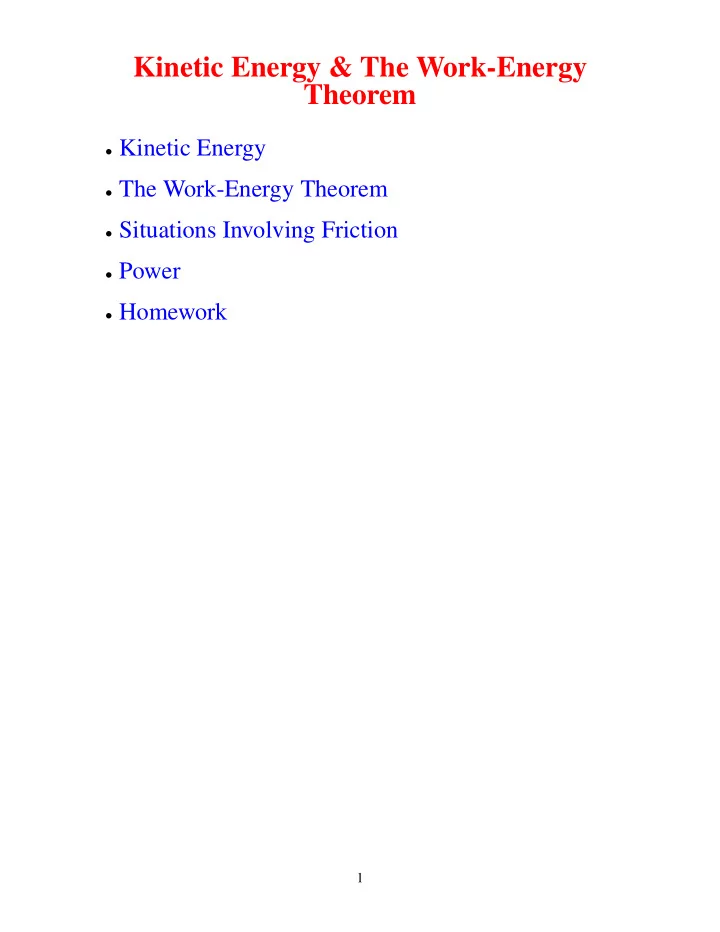

Kinetic Energy & The Work-Energy Theorem • Kinetic Energy • The Work-Energy Theorem • Situations Involving Friction • Power • Homework 1
Kinetic Energy • Consider a mass m that undergoes a displacement of magnitude ∆ x and a change in speed under the action � F of a constant net force � F is • The net work done by by the force � Fdx � x f W net = x i • Using Newton’s second law, we have x i mdv x i mdv dx � x f � x f � x f W net = x i madx = dtdx = dt dx dx x i mvdv = 1 f − 1 � x f 2 mv 2 2 mv 2 W net = i 2
Work-Energy Theorem • The kinetic energy is defined as K = 1 2 mv 2 • The work done by the net force on the system equals the change in kinetic energy of the system W net = K f − K i = ∆ K • This is known as the work-energy theorem • Units of K and W are the same (joules) • Note: when v is a constant, ∆ K = 0 and W net = 0 , e.g. Uniform circular motion 3
Work-Energy Example 1 Assume the force of gravity to be constant for small dis- tances above the surface of the earth. A body is dropped from rest at a height h above the earth’s surface. If we ignore air resistance, what will its kinetic energy be just before it strikes the ground? 4
Work-Energy Example 1 Solution Assume the force of gravity to be constant for small dis- tances above the surface of the earth. A body is dropped from rest at a height h above the earth’s surface. If we ignore air resistance, what will its kinetic energy be just before it strikes the ground? W = F · ∆ r = − mg j · ( − h j ) = mgh ∆ K = K f − K i = 1 f − 0 = 1 2 mv 2 2 mv 2 f W = ∆ K mgh = 1 2 mv 2 f � v f = 2 gh 5
Work-Energy Example 2 A block with a mass of 5.7 kg slides on a frictionless table with a speed of 1.2 m/s. It is brought to rest by compressing a spring in its path. By how much is the spring compressed if its force constant is 1500 N/m? 6
Work-Energy Example 2 Solution A block with a mass of 5.7 kg slides on a frictionless table with a speed of 1.2 m/s. It is brought to rest by compressing a spring in its path. By how much is the spring compressed if its force constant is 1500 N/m? � x f � x f � r f W = r i F · d r = ( kx i ) · ( − dx i ) = ( − kx ) dx 0 0 W = − 1 2 kx 2 f ∆ K = K f − K i = 0 − 1 2 mv 2 i W = ∆ K − 1 f = − 1 2 kx 2 2 mv 2 i � � m 5 . 7 kg � � � � 1500 N/m = 7 . 4 × 10 − 2 m x f = v i � k = (1 . 2 m/s ) � � � � � x f = 7 . 4 cm 7
Situations Involving Friction • Consider a block sliding along a surface that is not frictionless • The change in kinetic energy is � W other forces ∆ K = − f k ∆ x + • If we consider the system consisting of the block and surface as the block slows down under the influence of friction alone, we have ∆ K + ∆ E int = 0 • By comparing the two eqns above, we see that the increase in internal energy of the system is equal to the product of the friction force and the displacement of the block ∆ E int = f k ∆ x 8
Power • Power is defined as the rate at which work is done or energy is transferred • Average power P = W ∆ t • Instantaneous power W ∆ t = dW P = lim dt ∆ t → 0 • The power can also be written as P = dW dt = F · d r dt = F · v • The most general expression for power is P = dE dt • Unit is the watt (W) - 1 W = 1 J/s 9
Homework 11 - Due Wed. Oct. 6 • Read Sections 6.5-6.8 • Answer Questions 6.10 & 6.12 • Do Problems 6.19, 6.24, 6.30 & 6.38 10
Recommend
More recommend